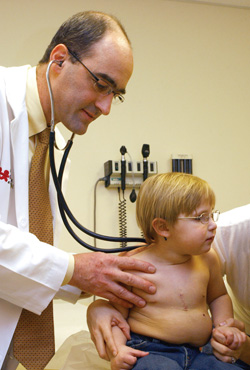
David Bichell, M.D., examines Haydan Paris during his follow-up appointment. (photo by Susan Urmy)
Parents now have options for child’s heart surgery scar
Haydan Paris is too busy learning to walk to worry about the new scar on his chest.
The 1-year-old's parents aren't concerned either. As a matter of fact, they chose the scar ahead of time.
In what's become a growing trend in pediatric surgery — selecting a child's scar for future cosmetic reasons — surgeons at the Monroe Carell Jr. Children's Hospital at Vanderbilt are offering options to many parents of children who need open-heart surgery to offset concerns about 'fitting in' later in life.
“You can't say this is the standard yet, because many surgeons don't offer this,” said David Bichell, M.D., chief of Pediatric Cardiac Surgery. “But we now can do open-heart surgery in a much more narrow opening without changing the safety of the surgery at all.”
The standard open heart-incision, basically from the base of the neck to just above the belly, is still necessary in cases where the surgery is risky, the child is particularly sick or there is likelihood that the child might need more surgery later on, but for children who are good candidates, the incision can be made several inches smaller.
Girls have a nice option these days called a sub-mammary scar: a scar that is side-to-side, just under the breast tissue, rather than a vertical scar on the chest, said heart surgeon Karla Christian, M.D.
“It's a big crowd pleaser in the 15- to 20-year-old group (adolescent girls), because it can be hidden with a bathing suit top and leaves no visible scars with a V-neck shirt,” said Christian. “Post-operative pain is no different either.
“However, it's really not a good option for boys. As they grow, the scar's effect on a man is that it tends to give them the sense they have breasts. The other thing to bear in mind is the outside scar is the only part that is transverse. On the inside, we divide the chest up and down.”
Christian says parents of one infant girl once sent her a Christmas photo of the baby, and Christian had to think about what kind of surgery she had done, because the folds of baby fat completely hid the scar on the girl's chest.
“The downside is I often have parents who come to me asking about these different scar options before I bring it up, so I have to disappoint some parents whose children are not candidates. Parents are networking so much more now, with the internet and groups like Saving Little Hearts, that they often tell me what they want.” Christian said.
Of course, the best new option is no surgery at all, which has become increasingly possible with round, patch-like pieces of mesh called occlusion devices that can be placed with a catheter through a leg or arm. But not everything can be done in the cath lab. Haydan Paris had the type of defect that can often be closed with occlusion devices — a hole between the upper chambers of his heart called an atrial septal defect, or ASD — but a cath lab procedure wasn't an option in his case.
“He had a larger hole that was set off to one side, and the rim around the hole wasn't suitable for the occlusion devices. It was just safer to do open-heart surgery in his case.” Bichell said.
Haydan's father, Chris Paris, is a third-year resident at Vanderbilt University Medical Center, soon to be headed for a cardiology fellowship he had planned long before he ever knew his son had a heart defect. Chris and his wife, Katherine, were happily surprised by Haydan's 1.5-inch scar.
“We had talked about it before surgery, but I'm still amazed at how small the incision is. We are extremely happy that his scar will be so much less noticeable when Haydan gets older,” he said.
The larger incisions that were the standard for decades were favored because of the tubes that must carry the blood to the bypass machine to take over the work of the heart and lungs during surgery. The tubes, called cannulas, connect to major vessels at the top of, and behind the heart.
“Over the years, with repetition, our confidence has increased, so we have simply cut down on the excess space we require in the chest during surgery,” Bichell said.
During surgery, curved clamps and more flexible tubing allow surgeons to enter the chest at an angle, beginning about halfway down the sternum. Tools and tubes can curve up above and behind the heart with relative ease. Incisions of only about two inches are now considered to be just as safe and effective as opening the chest much wider.
“It's like we felt we needed these big double doors to see what we were doing to work on the heart. Now we just open the appropriate sized window,” Bichell said.













